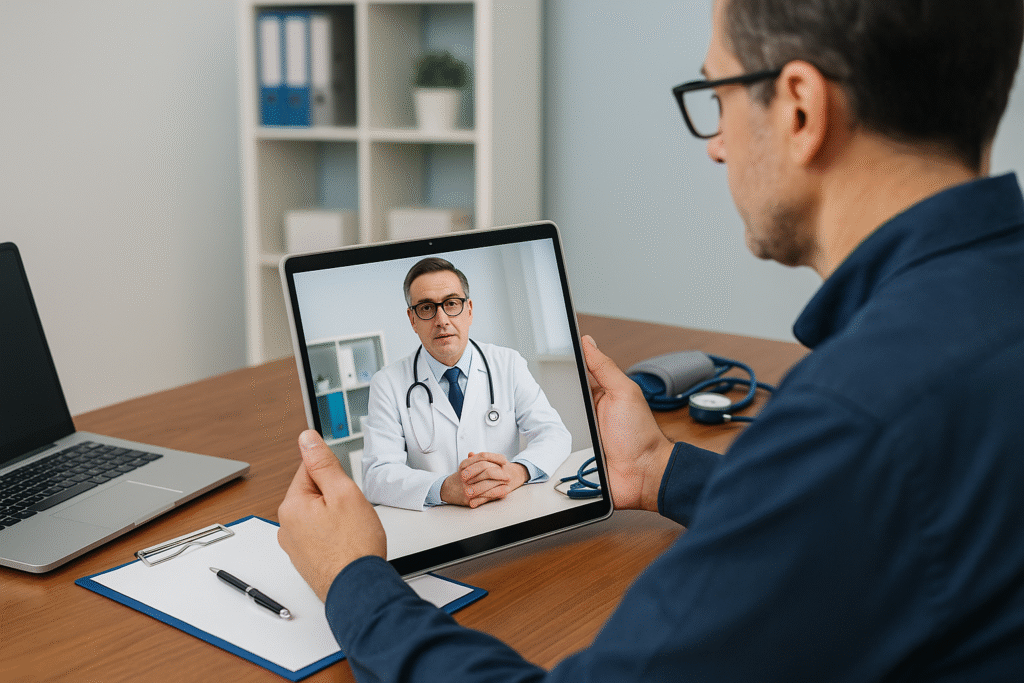Telehealth appointments and virtual medical records are now a regular part of healthcare. What started as a convenience during the pandemic has become standard practice in injury cases across Texas. For those seeking compensation after an accident, the way medical evidence is collected and presented is changing quickly. At Orange Law, we help clients use telehealth injury documentation effectively in court.
How Telehealth Works in Personal Injury Cases
After a car crash or a slip-and-fall, many clients first meet with doctors through video consultations. This approach allows faster access to care, especially in areas with limited specialists. Patients receive treatment plans, follow-ups, and diagnostic interpretations entirely through virtual appointments.
In a telehealth injury case, every session with a physician is recorded digitally. The physician’s notes, diagnoses, and prescribed treatments become part of a virtual medical record. These virtual medical records can be submitted as evidence in court to prove the seriousness of the injury, the duration of pain, and the recovery methods recommended by doctors.
Are Virtual Medical Records Admissible in Texas Courts?
Yes. Texas courts recognize virtual medical records just as they do physical charts and handwritten doctor notes. These records are well-organized, timestamped, and traceable, making them easier for attorneys and judges to review. However, to be legally valid, they must meet standards of authenticity and reliability.
The Orange Law team works with medical providers to make every digital record legally valid so that lawyers from the other side cannot doubt their genuineness.
Strengths of Using Telemedicine in Court
Using telemedicine in court offers several advantages in a personal injury claim:
- Detailed documentation: Instead of the doctor’s handwritten notes, digital records save everything electronically, like scan results and progress details from each visit.
- Faster access to specialists: Clients can speak with neurologists, orthopedic surgeons, or pain management experts without the delays of travel or waiting rooms.
- Continuity of care: Clients recovering at home can maintain regular contact with their medical team through virtual check-ins.
In many injury claims, a physician’s ability to visually assess recovery—such as range of motion or visible bruising—is crucial. Telehealth injury assessments support this, provided the video connection is clear and reliable.

Challenges in Presenting Telehealth Evidence
Despite the benefits, some specific difficulties arise when telemedicine is used in court. Insurance companies may argue that virtual assessments lack the physical interaction required for accurate diagnoses. Defense attorneys may question whether a telehealth consultation carries the same weight as an in-person medical exam.
This is why the legal team at Orange Law prepares each case thoroughly. We ensure every virtual medical record is supported by imaging results, physician statements, and video evidence when available. We also coordinate with treating doctors to testify—virtually or in person—to explain how a diagnosis was made remotely.
How Orange Law Uses Telehealth Injury Evidence Strategically
Each injury case is different. Some require a mix of in-person and virtual evaluations. Others are handled entirely through telemedicine, especially when mobility limitations or geographic distance prevent travel.
At Orange Law, we:
- Work directly with your telehealth providers to gather certified medical records
- Obtain digital copies of all session summaries, prescriptions, and referrals
- Coordinate with your physicians to prepare for depositions or testimony
- Submit admissible virtual medical records in court according to evidentiary standards
Our attorneys focus on the quality and credibility of the medical evidence, not just its format.
Why Insurance Companies May Push Back
Insurance adjusters may try to devalue claims that rely heavily on telehealth injury documentation. They may argue:
- The medical exam wasn’t comprehensive
- The provider couldn’t physically assess mobility or pain
- The patient’s symptoms were self-reported without objective validation
To counter these arguments, we build the case using the complete set of available evidence—imaging results, therapy progress notes, treatment plans, and expert testimony from your virtual care team. When presented effectively, telemedicine in court becomes a strength, not a liability.
Real-World Example: Video Testimony Backed by Virtual Records
In a recent case handled by Orange Law, a client injured in a rideshare accident was unable to visit the hospital for follow-up due to serious mobility issues. All of his consultations—from physical therapy to orthopedic care—were conducted through telehealth.
The virtual medical records documented consistent complaints of pain, a clear pattern of recovery, and detailed treatment plans from three separate specialists. During the trial, each provider appeared via secure video conferencing and answered questions from the court. When the telehealth records were presented in court, the jury awarded full compensation to the client on that basis.
Tips for Injury Victims Relying on Telemedicine
If you’re recovering from an injury and using telehealth:
- Request and save digital summaries after each virtual consultation
- Maintain records of emails or messages confirming appointments and prescriptions
- Keep a personal log of symptoms, physical limitations, and recovery milestones
- Inform your attorney if any healthcare provider is unwilling to submit documents or testify
Your legal team can use this material to strengthen your telehealth injury claim.
Modern Injuries Need Modern Legal Strategy
The courtroom is evolving. Just as dashcam footage and digital communication have changed how evidence is viewed, telemedicine in court is reshaping how injury claims are proven.
At Orange Law, we stay ahead of these changes and help clients present modern medical evidence effectively. Even if your treatment took place through a screen, your injuries are real, and your case deserves full recognition.
We guarantee that virtual medical records will be taken seriously in court and that your rightful claim will be protected.
Don’t let insurance companies dismiss your telehealth injury. Contact Orange Law today for a free consultation and let us help you build a case backed by modern, credible evidence.



